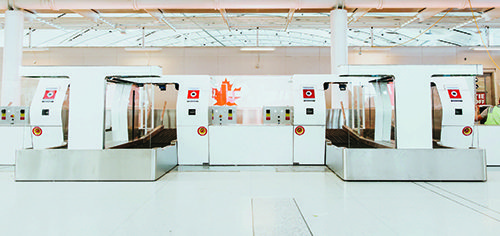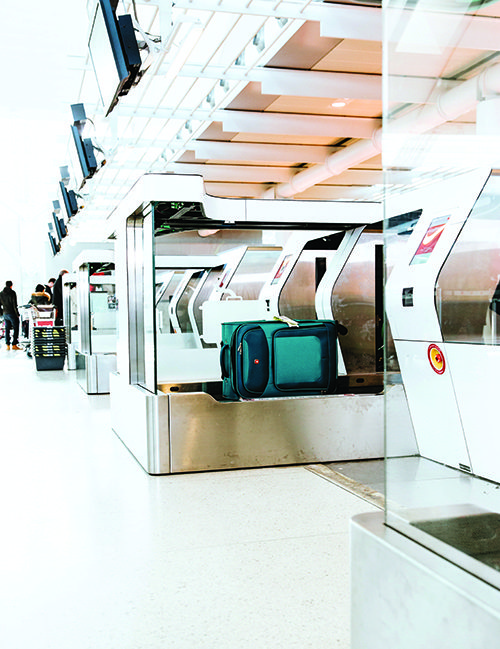With 46 self-service bag drops operating in its terminals as of mid-October, Toronto Pearson International (YYZ) is on the fast track to expediting the check-in process for passengers flying out of Canada’s biggest and busiest airport.
Since YYZ debuted its first self-service bag drop stations in January 2016, travelers have chosen the automated option more than 3 million times.
With 46 self-service bag drops operating in its terminals as of mid-October, Toronto Pearson International (YYZ) is on the fast track to expediting the check-in process for passengers flying out of Canada’s biggest and busiest airport.
Kurush Minocher, associate director of Airline Programs and Services for the Greater Toronto Airports Authority, explains that self-service bag drops reduce unnecessary touch points for passengers by allowing them to arrange their own check-in experience from a home computer, mobile device or self-service kiosk. After arriving at the airport, passengers can proceed to the baggage drop-off site, rather than standing in a queue to wait for check-in.
Automating the process shortens queues and reduces the end-to-end check-in time for passengers, reports Minocher.
|
Project: Self-Serve Bag Drop |
“Toronto Pearson is experiencing record growth and needed to find innovative ways to add check-in capacity,” he explains. “Reconfiguring check-in facilities in both terminals to increase the use of self-service technologies will deliver additional capacity for growth by allowing for increased throughput. Self-service bag drops also provide air carriers with a choice for how they wanted to deliver the check-in experience, either as a full-service or self-serve process.”
Since YYZ debuted its first self-service bag drop stations in January 2016, travelers have chosen the automated option more than 3 million times.
Materna Americas supplies the airport’s automated systems. Gary McDonald, the company’s president, notes that Materna systems reduce the bag drop process to mere seconds.
“One and one-half minutes is what an [airline] attendant spends with an average customer checking one bag,” he reports. “In contrast, we have self-service bag drops processing 120 bags per hour. You think of how many people have been helped without having to stand in a line, and it is huge.”
The fastest bag drop in the world, a Materna operation at Norway’s Oslo Airport, takes an average of 10 seconds, says McDonald.
Return on Investment
When it comes to value for cost, Minocher notes that YYZ’s self-service bag drops provide significant benefits for its customers.
 “Before investing in new technology like self-service bag drops, we evaluate multiple factors to determine what the best solution is, looking at our current situation and how those patterns would change in the future,” he explains. “Are we using our existing facilities to the best of their ability, or could we be more efficient? What is the cost, benefit and impact to the status quo if we don’t change? Our evaluation always maps back to our No. 1 goal, which is to push the envelope on improving the passenger experience.”
“Before investing in new technology like self-service bag drops, we evaluate multiple factors to determine what the best solution is, looking at our current situation and how those patterns would change in the future,” he explains. “Are we using our existing facilities to the best of their ability, or could we be more efficient? What is the cost, benefit and impact to the status quo if we don’t change? Our evaluation always maps back to our No. 1 goal, which is to push the envelope on improving the passenger experience.”
Minocher considers automating the airport’s checked bag process to be a sound investment, based on the improvements it provides for the passenger experience.
“Self-service bag drops have made the experience smoother and more enjoyable for passengers by reducing amount of time they need to check in,” he summarizes. “We see the [self-service drop stations] as part of the [overall] baggage handling system with live monitoring of the environment. The system provides real-time information on check-in throughput as it happens, which gives us the ability to map processing times to our other metrics in the terminal.”
Mutually Beneficial
Minocher reports very positive reactions from both passengers and air carriers.

Automating the bag drop process has shortened queues and reduced passenger check-in time at YYZ.
“Passengers enjoy having the option of using full-service or self-service check-in, which gives them the ability to manage their own experience,” he relates “Those who are using the self-service bag drops are seeing a reduction in check-in time, with a smoother, faster experience.”
Minocher has also noted a shift in the orientation of air carriers -from processing passengers to serving them.
Airline agents are able to spend more time helping travelers that require assistance, because other passengers choose to complete the check-in process independently at the self-service bag drops.
As of mid-September, 11 airlines were using YYZ’s self-service bag drop system.
Growing Demand
Following the successful rollout of the technology at YYZ, other Canadian airports are taking notice of the self-service option, reports McDonald. Aéroports de Montréal has ordered 16 variants of the Materna systems, and Québec City Jean Lesage International Airport has ordered eight units.
 Stateside, Minneapolis-St. Paul International is conducting a two-unit pilot in conjunction with American Airlines.
Stateside, Minneapolis-St. Paul International is conducting a two-unit pilot in conjunction with American Airlines.
“The airports have invested in this equipment to streamline the process for the airlines and to attract more airlines into the airport,” McDonald remarks. “Because [the self-serve bag drops] can process more bags than an agent at a desk, [airports] need fewer of these injection points. If they have the same number of injection points, they can get more airlines into the same space and cope with the expansion that is happening.”
In addition to operating one of the largest self-bag drop operations in Canada at YYZ, Materna also has the largest installation in the world at Gatwick Airport in London.




